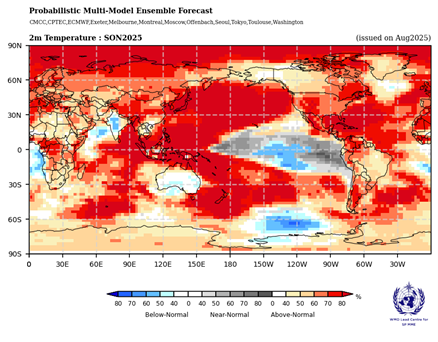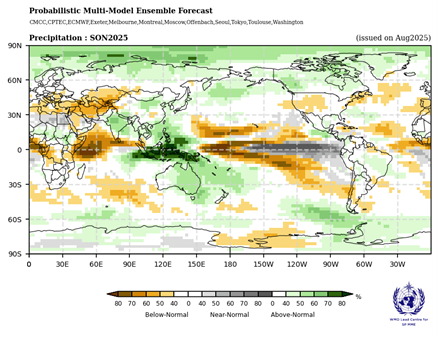Observed Oceanic Drivers for the Previous Season
During May-July (MJJ) 2025, global sea-surface temperature (SST) anomalies remained broadly above average, with particularly strong warmth across the extratropical latitudes.1 In the equatorial Pacific, SSTs near the Date Line were close to normal, and all Niño indices hovered near-average-except for Niño 1+2, which showed slight positive anomalies. Despite these near-neutral SST values, coupled ocean-atmosphere signals in the central and eastern Pacific retained features consistent with a weak La Niña (particularly for the observed rainfall anomalies). The Indian Ocean Dipole (IOD) index remained near average throughout the season, showing no sustained shift into either positive or negative phase. SST anomalies in both the North Tropical Atlantic (NTA) and South Tropical Atlantic (STA) were also close to normal, while above-normal SSTs persisted across the extratropical Atlantic.
Outlook for Oceanic Drivers for the Next Season
For SON 2025, sea-surface temperature (SST) anomalies in the Niño 3.4 and Niño 3 regions are forecast to decline, with the potential emergence of a weak La Niña. Continued above-average SSTs in the western Pacific are expected to strengthen the east-west SST gradient, reinforcing La Niña-like conditions across the equatorial Pacific. The Indian Ocean Dipole (IOD) index is also projected to weaken and shift into a negative phase. In the equatorial Atlantic, SSTs in the northern tropical region are forecast to remain above average, while the southern tropical Atlantic is expected to stay near average.
Surface Temperature Outlook for the Next Season
For SON 2025, the multi-model ensemble forecast indicates a strong global signal for enhanced probabilities of above-normal surface temperatures, with generally high model agreement across much of the Northern Hemisphere. Southern regions of North America, western Europe, northwest Africa, northern Asia, eastern Asia, and the Arctic Circle all show elevated probabilities for above-normal conditions, with robust consistency among models. In the Southern Hemisphere, enhanced probabilities for above-normal temperatures are predicted over New Zealand and the western half of South America, while most of Australia shows a lack of consistent signal.
In the tropics, a strong enhancement in the probability of above-normal temperatures is forecast across equatorial Africa, Southeast Asia, and the Maritime Continent. These regions also exhibit moderate to strong model agreement, supporting the likelihood of persistent warmth.
Over the oceans, widespread above-normal temperatures are projected across the North Pacific, North Atlantic, and Indian Ocean basins, with strong model agreement reinforcing the signal. Cooler-than-normal conditions are limited but appear in a coherent patch in the South Pacific near 120°W. Over the equatorial Pacific, west of the Date Line, probabilities for near-normal temperatures are enhanced, while a region between 150°W and 120°W shows increased probabilities for below-normal conditions.
Rainfall Outlook for the Next Season
For SON 2025, rainfall predictions in the equatorial Pacific align with an enhanced positive east-west sea surface temperature gradient, resembling conditions typically observed during a moderate La Niña-even though SST forecasts suggest only a weak La Niña may emerge. Enhanced probabilities for below-normal rainfall are expected to extend eastward from 150°E to near the Date Line. The northern branch of this dry signal continues eastward towards the western coast of Central America, while the southern branch extends southeastward to the western coastal regions of South America near 35°S. Along the equator, probabilities for near-normal rainfall are predicted from the Date Line to the western coast of South America. Overall, the SON 2025 rainfall outlook reflects a La Niña-influenced pattern, with suppressed rainfall over the central and eastern Pacific and enhanced rainfall over the western Pacific and adjacent land regions. Additionally, enhanced probabilities for near- or below-normal rainfall are predicted over the equatorial Atlantic, southern Europe extending into central Asia, coastal areas near the Gulf of Guinea, the Greater Horn of Africa, and western parts of North America. Probabilities for above-normal rainfall are increased over the Indian subcontinent, Southeast Asia, the Maritime Continent, regions around the Philippines, eastern half of Australia, northern regions of North America, and a band along 60°S in the southern Pacific Ocean.


1 https://www.cpc.ncep.noaa.gov/products/people/mchen/AttributionAnalysis… ;






